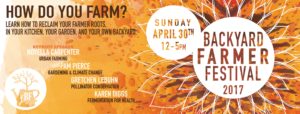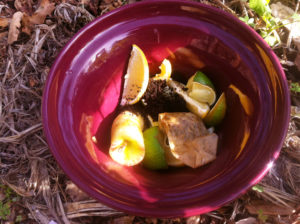Gardening
Fairfax Backyard Farmer Festival- April 30
Join the Fairfax Backyard Farmer for a day of workshop demos, tastings, and a Speaker Symposium on the scales of “farming.”
Listen as Pam Pierce speaks of global Climate Change and gardens, Gretchen LeBuhn talks of bio-regional pollinators, Novella Carpenter discusses Urban Farming, and Karen Diggs addresses the human microbiome. Lectures conclude with a Backyard Farmer Panel Q & A.
Learn more about the event here.
Sustainable Fairfax is pleased to be a sponsor of this event!
Oro Negro: Turning Food Waste into Gold
Oro negro! declared the late Pedro Hernandez as he dug the compost each winter. Black gold! Pedro was from Guatemala and gardened fourteen years for my dear English landlady. My sister, who lives in Hawaii, likes to tell me about showing her house to guests; her tours always include her compost full of worms. Certain that they find this odd, she does it anyway, sharing her love of transforming old vegetables, fruits, and grass clippings into fine loose soil.
It’s organic. It will go into the earth said our mother, allowing my sister and me to throw apple cores out the car window (do not do this now, you could be arrested!). I experienced my first compost as a child, living in rural Colorado. Since then I have lived in many places—town and country—and nearly always had a compost; I cannot bear to throw out good kitchen scraps. Sometimes, quietly, I bring scraps home if a compost is unavailable.
My sister and I make an uneasy peace with uneaten food knowing it will make happy plants and worms. We also monitor our purchases as best we can, not always an easy task when plans change or we buy more than we can eat.
Food waste is a big problem in America as NPR reported last fall. Statistics indicate that we waste 40 percent of our food. In Marin, over 25% of our landfill waste is food. Recently I learned that organic matter in landfills is a source of global warming creating at least two greenhouse gases, methane and carbon dioxide (CO2). Methane is particularly harmful, 20 times more potent than carbon dioxide. Composting greatly reduces methane production. Additionally it holds onto the carbon dioxide it creates, making it available for plants to use. Pretty cool!
Composting not only creates less waste, greenhouse emissions, but better health with oro negro for our farms and gardens. According to Marin Sanitary Services (MSS), 20% of Fairfax residents use their green bins for food waste and 47% use them for yard waste. What do you do?
Composting Tips: Composting is an art and a science; there are many ways to do it. The tips here are simple. To get a deeper knowledge of this art sign up for Sustainable Fairfax’s newsletter and learn about upcoming composting and worm bin workshops.
First. You will need to set up a system for transferring your kitchen waste to your green bin. There are many types of containers available commercially (see photos). Or be creative like my friend Leanne who uses an etched glass cookie jar.
Second. Decide whether you want to compost at home or let Marin Sanitary do it for you. In either case, collect your food scraps!
Keep it at home. Designate a spot in your yard for your compost—even a simple pile works. Empty your container and use a shovel to lightly cover the fresh scraps with a bit of dirt, grass, wood ash, woodchips, or straw. To aerate your pile, turn it occasionally. Or dig your scraps directly into the earth as my friend does in the narrow garden bed edging his small bungalow. That’s it! Negro Oro!
For a more contained pile, purchase an enclosed compost bin; there are many types available. Or make a cylinder of chicken wire, as small or big as suits your space (see photos). Watch it become crumbly dark soil and use it to top dress your plants.
Or send it away via your MSS green bin to their composting facility in Zamora, Yolo County. Using current technology and constant monitoring they make a good hot compost, between 140º-170º. The resulting compost is distributed to farmers. Each year, several free deliveries are made to Fairfax residents (see Sustainable Fairfax’s calendar for delivery dates).
You can put all your food scraps, vegetable and animal, plus food soiled paper bags, napkins, and towels in the green bin. High heat composts kill pathogens, transforming animal products into soil. Do not put animal scraps into your home compost. Follow this link to learn what goes in your green waste bin. Please note that you cannot put compostable bio-plastics in the green bin—at least not yet!
Keep your green bin clean by putting food scraps in a paper bag before you dump them. Or line the bottom with yard trimmings, newspaper, or paper bags. Like my grandmother Grace, I freeze any animal and dairy scraps before putting them in the green bin just before pick-up. This cuts down on smells and fools the critters.
See Deborah Koons Garcia’s documentary, Symphony of the Soil. It will inspire you!
Please comment on your own composting tips and questions.
Have fun and feed the worms!
Bay Friendly Gardening Workshops

Need inspiration for your garden makeover? Want to learn the “Seven Principles” of Bay Friendly gardening?
Thank you to all the MMWD customers who made our first year (of holding summer classes at Sustainable Fairfax) such a success!!
A big thanks goes out to the Water District’s teachers, Earthsite and our sponsor www.yourgardenshow.com with whose assistance made this summer classes a huge hit!
Visit the Bay Friendly Coalition for future Bay Friendly gardening classes by MMWD in the spring.
7 Principles of Bay-Friendly Landscapes
1. Landscape Locally
recognizes that built landscapes are a part of the larger ecosystem of the San Francisco Bay watershed and that they can contribute to it’s health if designed and maintained using sustainable practices
2. Landscape for Less to the Landfill
means that we should reduce waste by choosing the right plants, avoiding invasive plant species, using recycled and salvaged products in the landscape and by composting, mulching and grasscycling plant debris.
3. Nurture the Soil
soils are living ecosystems and when landscape practices allow the soil food web to thrive it can filter pollution, store water, provide plant nutrients, and help plants resist pests naturally.
4. Conserve Water
means using a holistic approach of creating drought resistant soils with compost and mulch, selecting plants naturally adapted to summer-dry climates, using stormwater, greywater and recycled water in the landscape as much as possible and using efficient irrigation systems that include self-adjusting, weather-based controllers.
5. Conserve Energy
by reducing the need for mowing and shearing, by shading buildings and paved areas, using efficient outdoor lighting, and buying local landscape products.
6. Protect Water and Air Quality
through maximizing permeable surfaces and minimizing stormwater runoff, using integrated pest management, minimizing the use of synthetic pesticides and avoiding overuse of fertilizers, reducing fossil fuel consumption, and planting trees to remove CO2 and absorb air pollutants.
7. Create Wildlife Habitat
recognizes that biodiversity is crucial to the health of natural ecosystems and that by using native plants and increasing the diversity of plant palettes, our built landscape can provide food, water and shelter for birds, butterflies, beneficial insects and other creatures
About Our Rain Garden
In 2005, when we began designing our Sustainable Backyard, Fairfax and San Anselmo got hit with the second 100-year flood in 25 years. We believe that climate change is causing extreme weather and raising the sea level, which only means more flooding for us.
What can we do? That is what we asked Geoff Hall and Kamala Bennet of Sentient Design, who were working with us to design a backyard that represented best practices. The said “Water Reclamation” What’s that? For us it meant re-guttering our small house with about 600 square foot roof. Then channeling that water into a 1000 gallon tank. And directing the overflow of the tank into our pond and then into two vernal ponds. Our pond is lined and permanent. Our vernal ponds or swales are unlined seasonal water features. Please check the read more section below to learn more about how you can plant a vernal pond.
Since we set up this system we have found that the first rain of the season fills our tank. We actually found that in an average rainfall year we will be routing 15,000 gallons of water. We have had visits from the Town Council, County Board of Supervisors, FEMA and the Dept. of Homeland Security, MMWD, MCSTOPPP, SPAWN, Regenerative Design Institute, and numerous citizens. We received funding from Marin County Board of Supervisors to make this work possible.
Our system not only demonstrates how to help prevent flooding, it also creates unique microclimates, cleans the water before returning it to our creek systems, it helps to recharge our local ground water system, and we have 1000 gallons of water to use during the summer for topping up our pond or emergencies. In permaculture the water mantra is Slow it, Spread it, and Sink it.
Visit our backyard to learn more. Or check out this video. http://www.youtube.com/watch?v=8nyzNMzk4W0
We also have a rain_garden_brochure for you to view.
Visit the SPAWN site for more info on rainwater harvesting.

